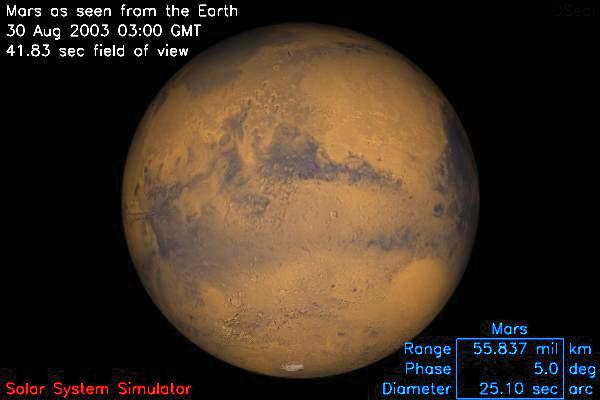

This simulated view for 0300 UT on August 30 (2200 CDT on the 29th) shows the side of Mars we will see then. (This is from the JPL Solar System Simulator). The south polar cap is currently larger and more prominent than this image shows, with an irregular edge as some regions vanish more soowly than others during the Martian southern-hemisphere summer. Our telescopic view will be inverted (rotated 180 degrees).
The landing site for Spirit, the first Mars Exploration Rover, is near the equator just south of the center of our view (close to the tip of the pipe bowl of Sinus Meridiani). A light region on the southeast edge of the disk marks the immense impact crater Hellas, largest on the "old" half of the Martian surface and possibly the largest in the Solar System. As it rotates out of our view, the second-largest such basin, Argye, takes its place on the western (sunrise) side of Mars. Likewise, the "Eye of Mars", Solis Lacus, will come into view after midnight. Its northern "eyelid" marks the immense Vallis Marineris canyon system. The huge volcanos of the Tharsis Bulge will be coming around the morning edge of Mars later in the night. The famous dark feature Syrtis Major, the first feature to have been recognizably seen by early observers, is just headed around the edge of the planet into night by the time we should get started tonight.
And in case the weather unexpectedly becomes really clear, we might just be able to see the tiny moons Phobos and Deimos, on opposite sides of the planet. Phobos is clear of the planet's glare for only about an hour at a time.
Mars rotation simulation from the Mars Global Surveyor.
keel@bildad.astr.ua.eduLast changes: August 2003